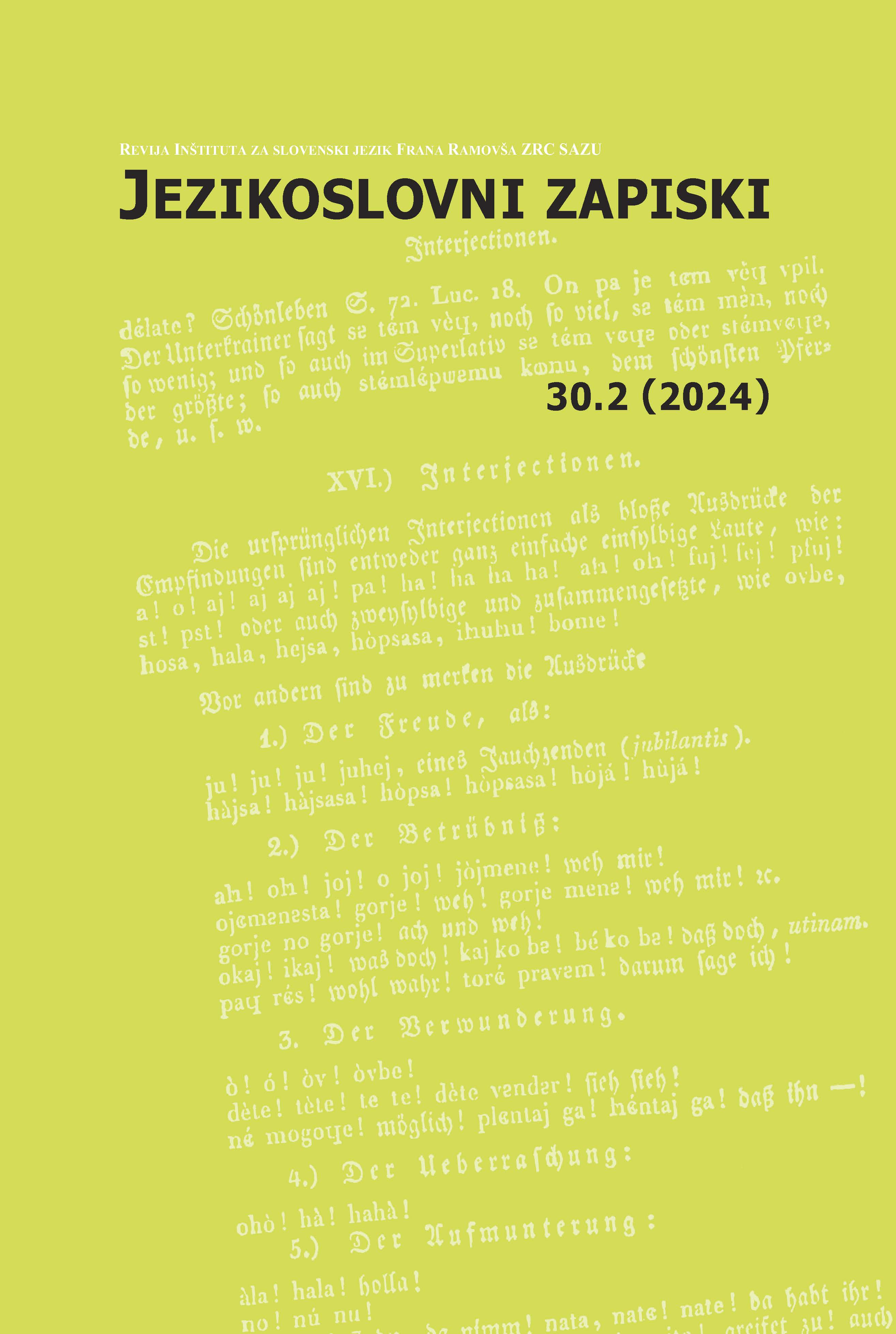The Challenges of Relative Chronology of Labiovelar Development in Anatolian
DOI:
https://doi.org/10.3986/JZ.30.2.04Keywords:
Proto-Indo-European, Anatolian languages, Hittite, labiovelars, syllabic resonants, relative chronologyAbstract
This article discusses the phonemic status of reflexes of Proto-Indo-European labiovelars in the Anatolian language group with regard to their diachronic development and the relative chronology of relevant sound changes. This mainly concerns the interaction of labiovelars and the labial
glide with syllabic resonants. The relative chronology points to a separate Proto-Anatolian resyllabification of syllabic resonants in contact with the labial glide and labiovelars, whereas the later syllabic decomposition is its own, probably intra-Anatolian process. This explanation also accounts for the divergent development of a small group of verbs in which resyllabification is blocked in a particular phonetic environment, whereas the o vocalism in the attested reflexes of resyllabification is instead the result of a separate late sound change.
Downloads
References
Adiego 2001 = Ignacio-J. Adiego, Lenición y acento en protoanatolio, v: Anatolisch und Indogermanisch = Anatolico e indoeuropeo: Akten des Kolloquiums der Indogermanischen Gesellschaft Pavia, 22.–25. September 1998, ur. Onofrio Carruba – Wolfgang Meid, Innsbruck: Institut für Sprachwissenschaft der Universität Innsbruck, 2001, 11–18.
Beekes 2010 = Robert Beekes, Etymological Dictionary of Greek 1–2, sod. Lucien van Beek, Leiden – Boston: Brill, 2010.
Byrd 2018 = Andrew Miles Byrd, The phonology of Proto-Indo-European, v: Handbook of Comparative and Historical Indo-European Linguistics 3, ur. Jared Klein – Brian Joseph – Matthias Fritz, Berlin – Boston: De Gruyter Mouton, 2018, 2056–2078.
Clayton 2022 = John Clayton, Labiovelar loss and the rounding of syllabic liquids in Indo-Iranian, Indo-European Linguistics 10 (2022), 33–87.
Eichner 1973 = Heiner Eichner, Die Etymologie von heth. mehur, Münchener Studien zur Sprachwissenschaft 31 (1973), 53–107.
Kimball 1999 = Sara Kimball, Hittite Historical Phonology, Innsbruck: Institut für Sprachwissenschaft der Universität Innsbruck, 1999.
Kloekhorst 2007 = Alwin Kloekhorst, The Hittite Syllabification of PIE *CuR and *KR, v: Tabularia Hethaeorum: hethitologische Beiträge: Silvin Košak zum 65. Geburtstag, ur. Detlev Groddek – Marina Zorman, Wiesbaden: Harrasowitz Verlag, 2007, 455–457.
Kloekhorst 2008 = Alwin Kloekhorst, Etymological Dictionary of the Hittite Inherited Lexicon, Leiden: Brill, 2008.
Kümmel 2007 = Martin Joachim Kümmel, Konsonantenwandel: Bausteine zu einer Typologie des Lautwandels und ihre Konsequenzen für die vergleichende Rekonstruktion, Wiesbaden: Reichert, 2007.
Lausberg 1967 = Heinrich Lausberg, Romanische Sprachwissenschaft II: Konsonantismus, Berlin: Walter de Gruyter & Co., 1967.
Machek 1949 = Václav Machek, Hittitio-Slavica, Archív orientální 17.2 (1949), 131–141.
Meier-Brügger 2010 = Michael Meier-Brügger, Indogermanische Sprachwissenschaft, sod. Matthias Fritz – Manfred Mayrhofer, Berlin – New York: De Gruyter, 92010.
Meier-Brügger 2021 = Michael Meier-Brügger, Indogermanische Sprachwissenschaft, sod. Matthias Fritz, Berlin – Boston: De Gruyter, 2021.
Melchert 1994 = H. Craig Melchert, Anatolian Historical Phonology, Amsterdam – Atlanta: Rodopi, 1994.
Melchert 2012 = H. Craig Melchert, Luvo-Lycian Dorsal Stops Revisited, v: The Sound of Indo-European 2: Papers on Indo-European Phonetics, Phonemics, and Morphophonemics, ur. Roman Sukač – Ondřej Šefčík, München: Lincom Europa, 2012, 206–215.
Melchert 2020 = H. Craig Melchert, Hittite Historical Phonology after 100 Years (and after 20 Years), v: Hrozný and Hittite: the First Hundred Years, ur. Ronald I. Kim – Jana Mynářová – Peter Pavúk, Leiden – Boston: Brill, 2020, 258–276.
Oettinger 1979 = Norbert Oettinger, Die Stammbildung des hethitischen Verbums, Nürnberg: Verlag Hans Carl, 1979.
Patri 2019 = Sylvain Patri, Phonologie hittite, Leiden: Brill, 2019.
PHOIBLE = Steven Moran – Daniel McCloy (ur.), PHOIBLE 2.0, Jena: Max Planck Institute for the Science of Human History, https://phoible.org.
Downloads
Published
How to Cite
Issue
Section
License

This work is licensed under a Creative Commons Attribution-ShareAlike 4.0 International License.
Authors guarantee that the work is their own original creation and does not infringe any statutory or common-law copyright or any proprietary right of any third party. In case of claims by third parties, authors commit their self to defend the interests of the publisher, and shall cover any potential costs.
More in: Submission chapter





